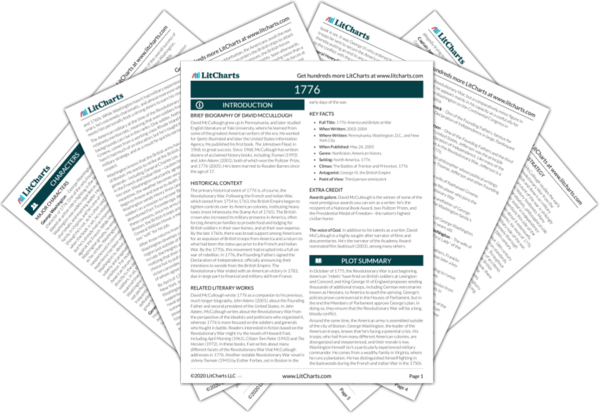Just as 1776 paints a picture of colonial American society, it paints a picture of British society of the 18th century, as reflected in the structures of the British military. From the beginning, David McCullough emphasizes the rigid class structures and social hierarchies of the British military. On one end of the social hierarchy, British foot soldiers knew their place and obeyed their commanding officers. If lowly British soldiers were given opportunities for social advancement, 1776 doesn’t mention them. By all appearances, the British military mirrored British society, in which working-class people were given few opportunities to move above their station. On the other end of the hierarchy, British generals were often appointed for their aristocratic rank in society, rather than for their talent as commanders. Many of the key commanders in the British war effort, such as General William Howe, weren’t brilliant tacticians by any means. They’d won their posts not simply because of their abilities but because they were from powerful, well-connected families. British society of the 18th century still subscribed to the view that aristocrats were inherently superior to “common people” by virtue of their heritage. Seen in this way, the structure of the British military—whereby second-rate people got the best jobs largely because their aristocratic roots—represented exactly what American revolutionaries such as Benjamin Franklin and Thomas Paine saw themselves as protesting against.
The British social system had plenty of advantages and disadvantages when compared with the slightly more meritocratic, upwardly mobile American social system of the same era. The British military—and arguably British society in general—was better organized and more disciplined than its American counterpart. This became obvious after the British army’s clash with Washington’s troops in Long Island and Brooklyn: the British forces’ superior organization and training led them to a victory that was among Washington’s first great humiliations in the war. At the same time, however, the British military structure had the disadvantage of being too rigid and inflexible to prove effective. Time and time again, the British army squandered opportunities to defeat Washington’s troops once and for all. As McCullough shows, British commanders were often unable to defeat Washington in battle simply because they were forced to await further instruction from General William Howe. On a similar note, the rigid organization of the British military discouraged British soldiers from fighting to the best of their abilities, since without many opportunities for advancement or distinction, soldiers didn’t have much of an incentive to perform beyond the bare minimum of what was expected of them.
In sum, what was true of the British military in 1776 was true of British society in 1776: Britain’s strict social hierarchy and dearth of class mobility impeded the country’s success. It’s important to keep in mind that Britain was probably more meritocratic and egalitarian than some other 18th century European nations. Nevertheless, British society and its military by extension were more rigidly hierarchical and socially stratified than fledgling American society. Partly as a result, McCullough implies, Americans were able to summon the motivation to defeat their bigger, stronger opponent and win the Revolutionary War.
British Society ThemeTracker

British Society Quotes in 1776
[King George III] had denounced the leaders of the uprising for having American independence as their true objective, something those leaders themselves had not yet openly declared.
But for all his raw courage in the heat and tumult of war, Billy Howe could be, in the intervals between actions, slow-moving, procrastinating, negligent in preparing for action, interested more in his own creature comforts and pleasures.
If the desperate American need for leaders had thrust young men like Nathanael Greene into positions beyond their experience, the British military system, wherein commissions were bought and aristocrats given preference, denied many men of ability roles they should have played.
Rather, in eighteenth-century military fashion, he hoped to maneuver Washington onto the open field, and then, with his superior, professional force, destroy the Yankee "rabel" in one grand, decisive victory.
But as thrilling as the news of Princeton was for the country coming so quickly after the triumph at Trenton, it was Trenton that meant the most, Trenton and the night crossing of the Delaware that were rightly seen as a great turning point. With the victory at Trenton came the realization that Americans had bested the enemy, bested the fearsome Hessians, the King's detested hirelings, outsmarted them and outfought them, and so might well again.
















